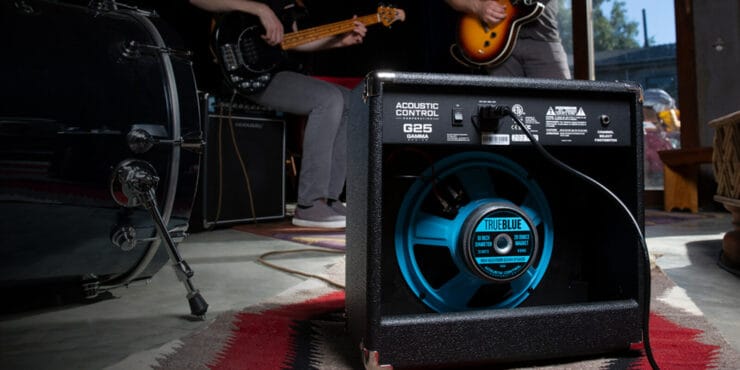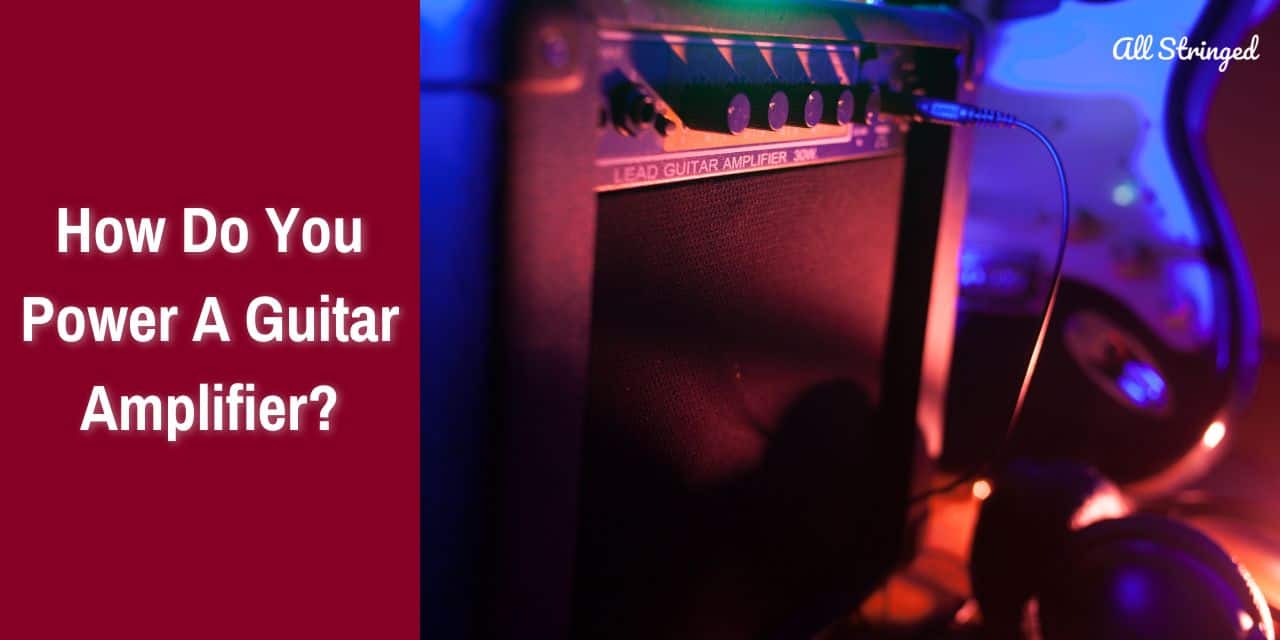Are you looking to get the most out of your guitar amplifier? Whether you’re a beginner or a master guitarist, powering your guitar amplifier properly can make a big difference in your playing. In this article, we’ll explore the different ways to power your guitar amplifier so that you can get the best sound out of your instrument. Read on to learn more and make sure your amplifier is always ready to rock!
What are the different components of a guitar amplifier?
The guitar amplifier or also known as a guitar amp is an important device for musicians and guitarists, especially those who play electric guitars. A guitar amplifier serves as a crucial link between the guitar and the audience, amplifying the electrical signal from the guitar’s pickups, shaping its tone, and projecting it through speakers. The guitar amplifier plays a key role in creating the desired sound and tone quality, allowing guitarists to showcase their skills and artistic expressions effectively.
>>> Click here to read our review about the Top 15 Best Battery-Powered Guitar Amps <<<
In simple terms, a guitar amp is an electronic device designed to amplify the sound produced by an electric guitar. Unlike acoustic guitars that produce sound through the vibration of strings, an electric guitar generates an electrical signal when the springs’ vibrations are picked up by the magnetic pickups. This electrical signal is weak and has to be amplified before it can be heard audibly. A guitar amp takes this low-level signal and boosts it to a level that can be projected through speakers, allowing the guitarist’s music to be heard by an audience or recorded for various purposes.
A typical guitar amp is comprised of several key components that work together to shape the guitar’s sound and deliver it with the desired tonal characteristics. A guitar amplifier typically consists of components like a preamp, tone controls, gain control, power amp, speakers, cabinet, effects loop, and more.
The preamp is the initial stage of the amp and is responsible for processing the weak electrical signal from the guitar’s pickups. It boosts the signal to a level suitable for further amplification. The preamp also plays a significant role in shaping the guitar’s tone through the use of tone controls, gain settings, and equalization (EQ) knobs.
Tone controls, often in the form of knobs on the front panel of the amp, allow the guitarists to adjust the tonal characteristics of the sound. Commonly, you will find bass, treble, and midrange controls, which can boost or cut specific frequency ranges, allowing the guitarist to tailor the sound to their preference or adapt to different playing styles and musical genres.
The gain controls on a guitar amp adjust the level of distortion or overdrive in the signal. Turning up the gain increases the amount of signal clipping, resulting in a more distorted and “crunchy” sound that is popular in rock and metal genres. Lower gain settings produce cleaner tones suitable for blues, jazz, and other clean styles.
The power amp is the section of the amplifier responsible for amplifying the preamp’s processed signal to a level that can drive the speakers. It provides the necessary power for producing sound at a volume suitable for performance or recording.
The speaker is where the amplified signal is projected as an audible sound. Guitar amps typically have one or more speakers housed within the amp’s cabinet. The speakers contribute significantly to the overall tone and character of the amp.
The cabinet is the enclosure that houses the entire amplifier setup, including the speakers. The materials and design of the cabinet also impact the amp’s tone and resonance.
Some guitar amplifiers come with an effects loop, which allows external effects pedals to be inserted between the preamp and power amp stages. This feature allows musicians and guitarists to apply effects (such as delay, reverb, or modulation) to the amplified signal without affecting the overall gain and tone settings.

Different types of power sources for guitar amplifiers
A guitar amplifier, the backbone of a guitarist’s sound, relies on various power sources to bring music to life. These power sources play a vital role in providing the necessary electrical energy to amplify the electric guitar’s signal and project it through the speakers. Here are the different types of power sources used in a guitar amp and how they impact the amp’s portability, performance, and overall functionality.
AC power
AC power, short for Alternating Current, is the most common and widely used power source for guitar amps, especially those designed for stage performances, studio recordings, and practice sessions. AC power is supplied by electrical outlets found in homes, studios, and concert venues. It is the most reliable power source for continuous use, as it provides a consistent voltage and current, ensuring a stable and consistent operation of the amplifier.
Amplifiers powered by AC have the advantage of being able to run for extended periods without the need for recharging or refueling. AC power provides a stable voltage and current, ensuring that the amp operates consistently and predictably, which is important during live performances or recording sessions. Unlike batteries, AC-powered amps don’t require regular maintenance or replacement, making them more convenient for everyday use.
Batteries
Guitar amps powered by batteries offer increased portability and flexibility. They are ideal for musicians who frequently perform in outdoor settings, busking, or traveling to places where AC power might not be readily available. Battery-powered amps are self-contained and can operate without being plugged into an electrical outlet.
Battery-powered amps are portable and lightweight, allowing musicians to take their music anywhere without the need for power cords or electrical outlets. For outdoor performances, street gigs, or camping sessions, battery-powered amps provide a reliable power source. Musicians in remote locations or areas with limited electrical access can play their music using battery-powered guitar amps.

Generators
Generators are devices that convert mechanical energy into electrical energy. They are occasionally used as power sources for guitar amps, especially in scenarios where AC power is unavailable or unreliable. Generators can be powered by different fuels, such as diesel, gasoline, or natural gas.
Generators can be used in locations without access to AC power, providing a versatile option for powering guitar amps in challenging environments. In situations where power outages may occur, using a generator can be a temporary solution to ensure the continuity of performances or recording sessions. Musicians performing in remote areas, outdoor festivals, or construction sites can rely on generators for a stable power source.
How to find the right power source for your guitar amplifier?
Selecting the right power source for your guitar amplifier will be an important decision that can significantly impact your performance, portability, and overall musical experience. Whether you play in live gigs, record in studios, or practice at home, understanding the different power options available and matching them to your specific needs is important. Here is how you can find out how to find the perfect power source for your guitar amplifier.
Purpose of use
The first step in choosing the ideal power source will be to determine how you intend on using your guitar amp. You need to consider different scenarios like live performances, studio recordings, practice sessions, and more.
If you frequently play live gigs, your primary consideration would be the availability of power outlets at the venues. In most cases, AC-powered amps are the standard choice for stage performances due to their consistent performance and unlimited operating time.
For studio recordings, AC power is typically the go-to option as it ensures a stable and noise-free power supply, essential for capturing high-quality audio.
If you often use your guitar amp for practice sessions at home, in a band rehearsal space, or for personal enjoyment, you have more flexibility in choosing between AC power, battery, or rechargeable options.
Musicians who travel frequently or perform in outdoor settings or engage in busking may prioritize portability. In such cases, battery-powered amps or those with built-in rechargeable batteries can be an amazing fit.
Type of amplifier
The type and model of your guitar amp an important role in determining the suitable power source. Different amps have different power requirements and design considerations. Different types of amps include AC-powered amps, battery-powered amps, and rechargeable amps.
Most standard guitar amps are designed to operate using AC power. They draw power from electrical outlets with varying voltage and frequency standards (e.g. 110V in North America and 220V in Europe). Ensure that your amp is compatible with the voltage in your region and consider investing in a voltage converter if you’re planning to travel internationally.
Battery-powered guitar amps offer enhanced portability, which makes them ideal for street performances, outdoor gigs, or practice sessions in remote locations. Check the battery life and consider carrying spare batteries or a power bank if needed.
Some guitar amps come with built-in rechargeable batteries, combining the convenience of portability with the ability to rechargeable the power source using AC power or USB ports.
Power requirements
Understanding the power requirements of your guitar amp is important to ensure proper functioning and prevent damage to the equipment. You should look for specifications on your amp’s label or manual like wattage, voltage, and current.
The wattage rating indicates the power output of the amp. Higher wattage amps are generally louder and suitable for larger venues while lower wattage amps are more suitable for practice or small gigs. For AC-powered amps, verify the required voltage and current specifications. Mismatching the power supply can result in damage or poor performance.
Budget considerations
The cost of the power source is also a vital factor to consider. AC-powered amps are generally more budget-friendly and cost-effective in the long run due to the absence of ongoing battery replacements. However, battery-powered and rechargeable amps might have higher upfront costs but can be more convenient for certain applications.
Sound quality
While the power source itself might not directly impact the sound quality of the guitar amp, the stability, and cleanliness of the power supply can affect performance. AC power is known for providing a consistent and noise-free energy source, ensuring the amp performs optimally and delivers a clear and crisp tone.
How do you power a guitar amplifier?
A guitar amp is the heart of a musician’s sound and knowing how do you power a guitar amplifier is important for ensuring a smooth and captivating performance. There are different methods to energize your guitar amp, each offering distinct advantages and catering to specific needs. Here are the different ways to power a guitar amplifier, highlighting the unique benefits and considerations of each method.
#1. Connecting to an AC power source
One of the most common and widely used methods of powering a guitar amplifier is by connecting it to an AC power source. This method is prevalent in live performances, studio recordings, and practice sessions where access to electrical outlets is readily available.
AC power ensures a stable and consistent flow of electricity, providing reliable performance during extended play sessions. When connected to an AC power source, your guitar amp can operate continuously without the need for battery replacements or recharging. AC power is readily available in most performance venues, recording studios, and homes, making it a convenient option for musicians.
To power your guitar amp using an AC power source, you need to follow these simple steps –
- Locate a nearby electrical outlet compatible with the voltage requirements of your amp (e.g. 110V or 220V)
- Connect the power cord provided with the guitar amp to the amp’s power input
- Insert the other end of the power cord into the electrical outlet
In the event of a power outage or technical issues with the electrical supply, your performance might be disrupted. It is important to have backup plans or alternative power options available if needed.
#2. Connecting to a battery
Guitar amps that are powered by a battery offer unparalleled portability, which makes them an excellent choice for musicians who frequently perform outdoors, travel, or engage in busking.
Battery-powered guitar amps are lightweight and allow musicians to perform in various locations without the need for electrical outlets. Musicians can perform in parks, street corners, or other outdoor settings without relying on AC power sources. The absence of power cords eliminates the risk of tripping over cables and offers greater flexibility on stage.
To power your guitar amp using batteries, you need to follow these steps –
- Insert the required batteries (usually 9V or AA) into the battery compartment of your guitar amp
- Make sure that the battery polarity is correct (as indicated in the amp’s user manual) to avoid damaging the amp
- Close the battery compartment securely
Check the estimated battery life offered by the manufacturer and carry spare batteries or a power bank for extended use. You should also regularly replace batteries to ensure uninterrupted performance and avoid unexpected power failures.
#3. Connecting to a generator
In situations where AC power is unavailable or unreliable, using a generator can be an effective way of powering your guitar amp. Generators convert mechanical energy into electrical energy, providing a versatile power solution for various environments.
Generators can be used in areas without access to AC power, offering a reliable power source in remote locations. In case of power outages during performances or recording sessions, a generator can act as a temporary power backup.
To power your guitar amp using a generator, here are the steps you need to follow –
- Place the generator in a safe and accessible location, away from the performance area, for minimizing noise interference
- Connect the guitar amp’s power cord to the generator’s electrical output socket
- Start the generator and ensure it is supplying the correct voltage and frequency required by your amp
Generators can produce noise that might interfere with the musical performance. Opt for quieter models or position the generator away from the audience and recording mics. Generators require fuel (e.g. diesel, gasoline, and natural gas) and regular maintenance for ensuring proper functioning. Be prepared with enough fuel for the duration of your performance or recording sessions.
Safety considerations when powering a guitar amplifier
When it comes to powering a guitar amp, safety should always be a top priority for musicians, guitarists, and performers. A secure electrical setup will not only protect your valuable equipment but also ensure your well-being and the safety of your audience. Here are the different safety considerations that you should remember when powering a guitar amplifier.
Grounding the amp
Grounding is a fundamental safety measure in electrical systems, including guitar amplifiers. Proper grounding will help protect against electrical shocks, reducing the risk of equipment, damage, and minimizing noise interference in your signal.
Grounding will provide a safe path for electrical currents to flow to the ground in case of a fault or short circuit. This will help prevent electric shocks and potential harm to the performer and audience. It helps protect your guitar amp and other connected devices from damage due to voltage spikes and power surges. Proper grounding can reduce or eliminate hums and buzzing sounds that might occur in the audio signal.
Grounding your guitar amp is typically done through the power cord and the amp’s three-longed plug. The third prong, known as the ground prong, connects to the ground wire in the electrical outlet or power strip. Here is how you can ensure proper grounding –
- Use a power cord with a three-pronged plug – Make sure that your guitar amp’s power cord has a three-pronged plug, with one of the prongs being the ground prong
- Utilize grounded electrical outlets – Plug your guitar amp into grounded electrical outlets or power strips, grounded outlets have three holes – two narrow slots and a round hole for the ground prong
- Avoid using adapters or removing the ground prong – Don’t use adapters or modify the power cord to remove the ground prong as it’ll compromise safety and eliminate the protective benefits of grounding
- Regularly check your equipment – Periodically inspect your power cords and outlets for signs of damage or wear and replace damaged cords and repair faulty outlets promptly
Avoid power surges
Power surges are sudden increases in voltage that can potentially damage electrical devices, including guitar amps. Although power surges are caused by external factors like lightning strikes or utility problems, these are measures that you can take to safeguard your gear.
Power surges can end up frying sensitive electronic components within your guitar amp, leading to costly repairs or replacements. A power surge during a live performance can end up disrupting your show and leave you without your most important gear.

To protect your guitar amp from power surges, there are numerous measures you can take such as using surge protectors, unplugging during storms, and more.
- You must invest in a high-quality surge protector/power strip with built-in surge protection as these devices help divert excess voltage away from your amp, safeguarding it from sudden spikes
- If a storm with lighting is approaching, you should unplug your guitar amp and other equipment from electrical outlets to avoid potential damage from lightning strikes
- Consider using a power conditioner, which will not only offer surge protection but also provide consistent power to the amp, filtering out any line noise or interference
- For critical performances, you should consider using a UPS (Uninterruptible Power Supply) as a backup power source since these devices offer battery power during brief power outages, allowing you time to safely shut down your equipment
FAQs
What are the different ways to power a guitar amplifier?
Guitar amplifiers can be powered in several different ways, including using an AC adapter, using batteries, using a preamp, or using a power amplifier. Each power source has its own set of advantages and disadvantages, so it’s important to consider which option is best for your needs.
What is the difference between an AC adapter and batteries for powering an amp?
An AC adapter is a wall outlet-based power source that is typically used for larger amplifiers. Batteries are portable, allowing you to practice anywhere, but require regular replacement and may not be suitable for larger amplifiers.
What is the difference between a preamp and a power amplifier?
A preamp is used to boost the signal of a guitar before it reaches the power amplifier, while a power amplifier increases the volume of the signal. Both are necessary for amplifying a guitar, but the type of amplifier you need will depend on the type of sound you are trying to achieve.



